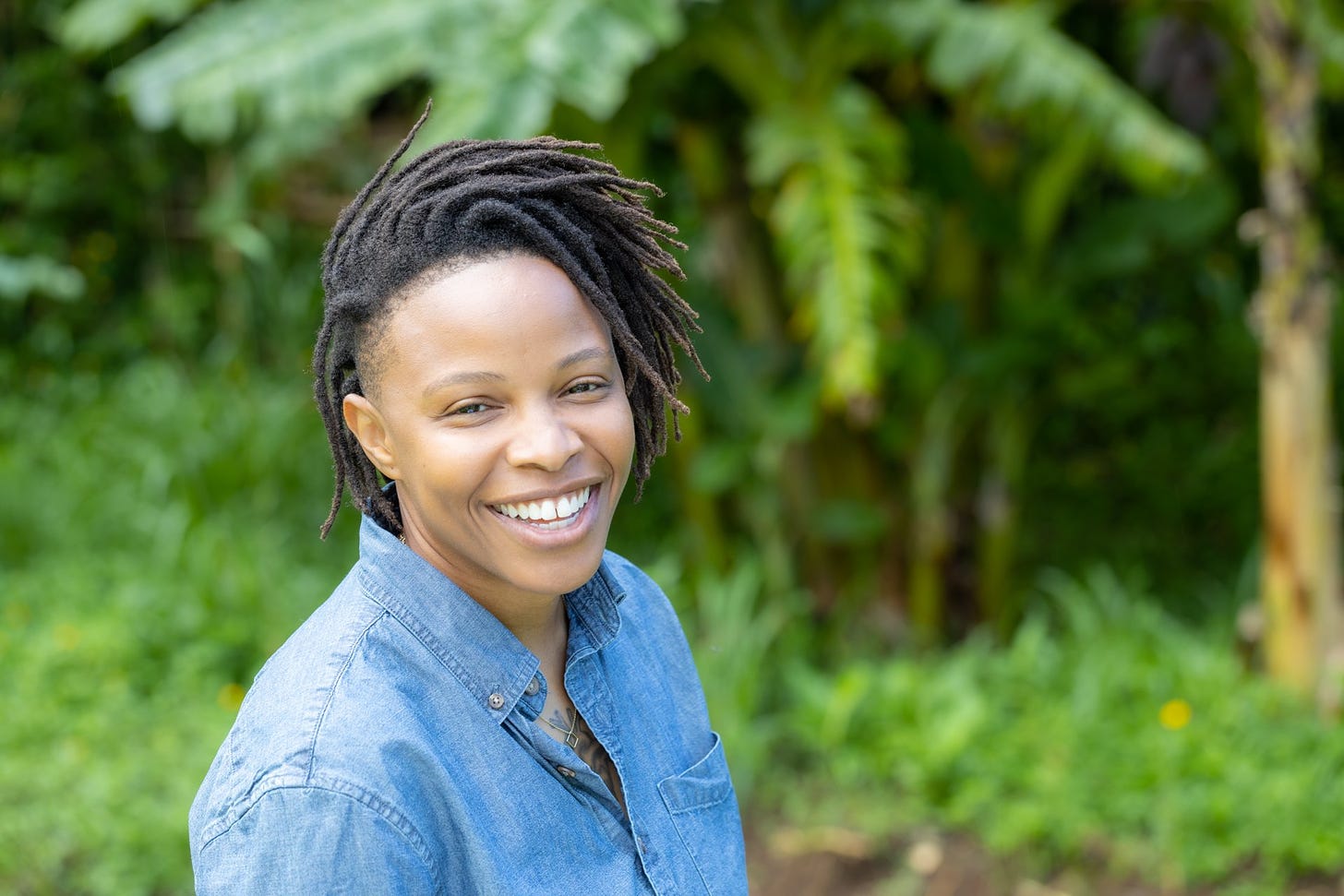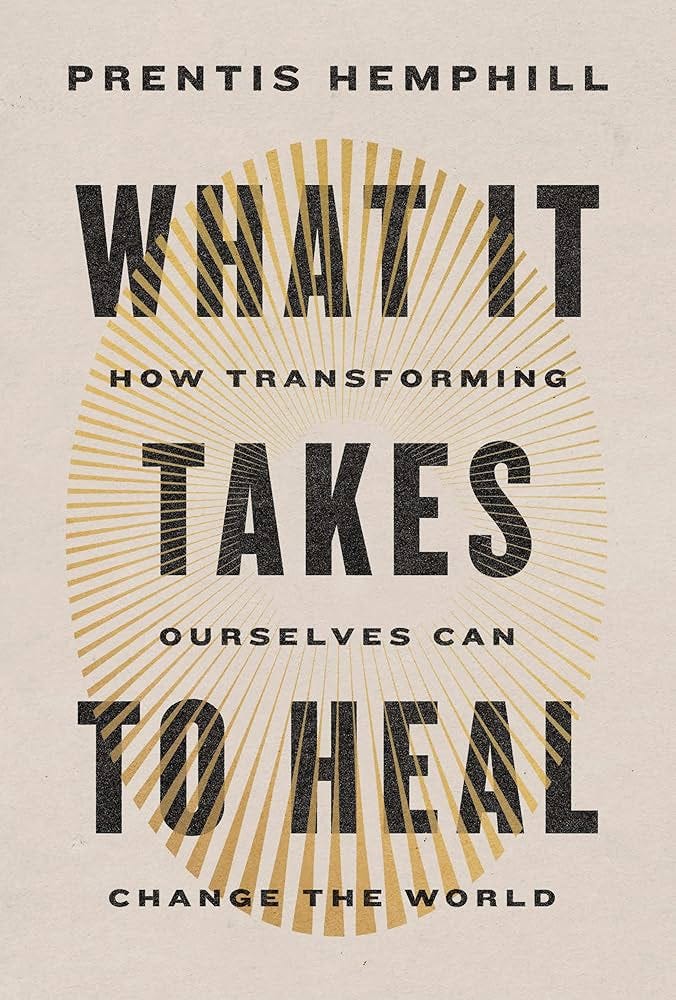Embodied politics, healing, and a chicken named Sesame
5 questions for somatics teacher, organizer, writer, and parent Prentis Hempill
Prentis Hemphill is perhaps most widely known for this incredible sentence:
It’s definitely an example of how a collection of just a dozen words can bring sudden clarity to generational confusion, right? If we live our lives as if boundaries are not punishment, but portals to the relationships we can actually live inside of for a long time (to make, as Marge Piercy puts it, “love that is loving”), what else might we be able to do? Holy shit, it really does take my breath away.
I was so excited to pick up Prentis Hemphill’s first book, What It Takes to Heal (edited by my dear friend Jamia Wilson, no less!), and there was no let down here. Somehow Prentis is an exquisitely powerful teacher and organizer, but also a writer. You rarely find this much talent in one human being, but here it is.
Maybe this tells us something, not just about their gifts, but about the power of embodiment - how really taking these practices seriously can unlock all kinds of clarity and talent that otherwise gets muddied by our monkey minds and forgotten bodies. In other words, this book and this person remind me to do the damn work! There are innumerable gifts through out and on the other side of it. Meet Prentis…
Courtney Martin: You write a lot about how becoming a parent has deepened your convictions about creating a more healed world, and also helped you continue along your own healing journey. What has your young child already taught you about healing that has surprised you?
Prentis Hempill: The learning started before the parenting did, in conceiving our child. As a queer family, it was a process, and a communal one. So there was longing, risk, loss all along the way. The process brought me into deeper intimacy with friends and my partner. I’ve also been learning lately that there is no way to prevent any bad thing from happening to her, but the power of witness is so healing. Her chicken friend, Sesame, died recently and we’ve done our best to explain what has happened to Sesame’s body. That she's returned to the earth and we visit where we’ve buried her. Her processing that loss has been a process. She wants to talk about it, not once, but many, many times.
You write about what I have sometimes heard called “the wounded healer” in such an amazing way--“Most of the time, we come to the work of making the world anew because of the pain this one has caused. Our wounds can give us the initial surge to fight back, though this energy is fueled by our. most frightened, defended, and adrenalized selves. Ultimately it’s not sustainable. The wound grows even as we use it, eating away at the person who holds it, acidifying all we do.” So for those of us who come to activist work out of a wound, initially, what do we need to do to stay in it without destroying ourselves?
Get to know the nature of the wound. It’s not that it isn’t or shouldn’t be invited to the work that we do, but when we keep it unconscious to ourselves we are also in a way not allowing it to be processed and inviting it to show up in unexpected places. Pain offers energy, it’s an alert, but it will wear you out to reactivate it or even to try to suppress it all the time. The other side of it I see is that we can allow and nurture our visions and imaginations. We tend to source our wounds for energy because it is easier and sometimes feels safer to believe only in what has happened and not in what might be.
You used this phrase, “sending pain down the ladders of power,” that took my breath away. Can you say more about that?
Yes, this understanding is really informed by my previous work as an advocate for domestic violence survivors. We understand, at least in that world, that abuse is fundamentally about power and control. So when I’ve had cases where people who are perpetrating violence threaten to turn people in around their immigration status or withhold financial resources, out someone to their family or in any other way exploit people’s vulnerability or position in society, I know that external power structures deeply influence power in our relationships. And I’ve seen far too many people on the dangerous end of these dynamics.
I’m also referencing here Sonya Renee Taylor’s articulation of this same ladder, this hierarchy of people, that gets trained into us and we keep scrambling up. The ladder, she talks about, works because we keep using it. And one of the ways we keep enforcing this ladder, in my opinion, is threat and violence.
Personally, this was something I saw in my home. Who could I take my pain out on that will disappear the pain because they are afraid to speak back to me? I think a lot of people deal with their inner turmoil, their disappointment, in these ways. They pass them on and expect others to absorb them on their behalf, others who are more vulnerable because of gender or age or ability or any number of other reasons.
I love your definition of politics-- “simply how we make decisions about the resources we have.” What would a more embodied politics look like in this country? How would we distribute resources if we were actually inside of our bodies, attending to our own healing, and the healing of our communities?
This is a question I’m thinking about a lot, especially in a moment where our political systems seem so in opposition to free bodies. There’s the question for me of, what decisions would we make if we intended for our bodies, and all bodies to feel resourced and supported?
This to me would make poverty, labor rights, social safety nets, priority issues. What decisions would we make if we knew that isolated and demoralized people, people who were made to stifle their own emotions and feelings suffer from those experiences and become more dangerous to the whole?
We blame mental health issues for so much of the violence of our society, but fail to look closely at our culture of the kind of isolation and despair people feel daily. Separating ourselves from our own sensations makes us less empathetic, causes us to deny our connection to each other and, therefore, allow really horrible things to happen to each other.
Embodied politics would be more interested in more people being able to breathe; they would recognize interconnectedness. It’s not that everything would be perfect, or that hard decisions wouldn’t be made at times, but we could understand the impact of hard decisions and not deny it. We would run less from our histories and we would build institutions that cared for human beings rather than tried so hard to narrow us.
You say, “Healing helps us fight in the places we need to, but love in the places we long to.” Where are you fighting and loving today? Paint a quick picture for us.
Currently fighting against homogeneity, mass violence, authoritarianism. In our collective terror at worsening crises we are contracting into us vs. them. I can understand the overwhelm and even the impulse, but our fear is being exploited to benefit those who have no intention of protecting any of us. I fight that through my work, supporting people to viscerally reconnect with each other.
And I support it through showing up, through organizing and supporting people who are organizing now against these same forces. And interestingly, I fight it through loving what I love. I am loving my family and my friendships. I am loving the surprises life offers me. I am touring around with this book right now and at every stop I take a long walk or a hike so I can introduce myself to the place, to the land. And I love the way I have been greeted and held by all the different kinds of life on this planet.
Buy the book here. Listen to Prentis’ wisdom on their podcast, Becoming the People. We are donating $250 to The Embodiment Institute out of the paid membership pool. Please pile on, and become a paid subscriber if you want to be part of this little giving circle model.
There are so many great videos out there to watch of Prentis in conversation with others on their book tour, but here’s one that was wonderful—full of laughter and depth.






Thank you for this! Prentis is one of my all-time favorite thinkers, has been for years, and when I read their book it just cemented that status for me. I underlined SO MANY lines, took furious notes in the margins, and broke out in audible AMENS! on the regular.
Growing up Quaker meant growing up around a lot of very earnest and intellectual folk who were super committed to changing the world outside themselves but not always (often) great at grappling with their own, private need for healing and embodiment. It created so much dissonance and disillusionment for me, but also a powerful drive towards integrity, as in integration, as in wholeness and healing. Prentis has helped me appreciate how that experience of dissonance can be a powerful motivation for change, not just in my own, little corner of the world but for the whole world. Helping folks acknowledge and work through it with a deep sense of mercy and compassion is the most important work I will ever do.
This awesome wisdom from PH about pain and healing couldn’t be more timely and helpful. Thank you!
The part about loving recalls James Baldwin’s eloquent appeal to his nephew at the end of his Letter to him in Fire Next Time. Then bell hooks complements PH as well. I’m sure that you’re familiar with these books and I’d like to remember as well Plato’s classic on love entitled The Symposium that Courtney and I studied together at Barnard 25 years ago. DD